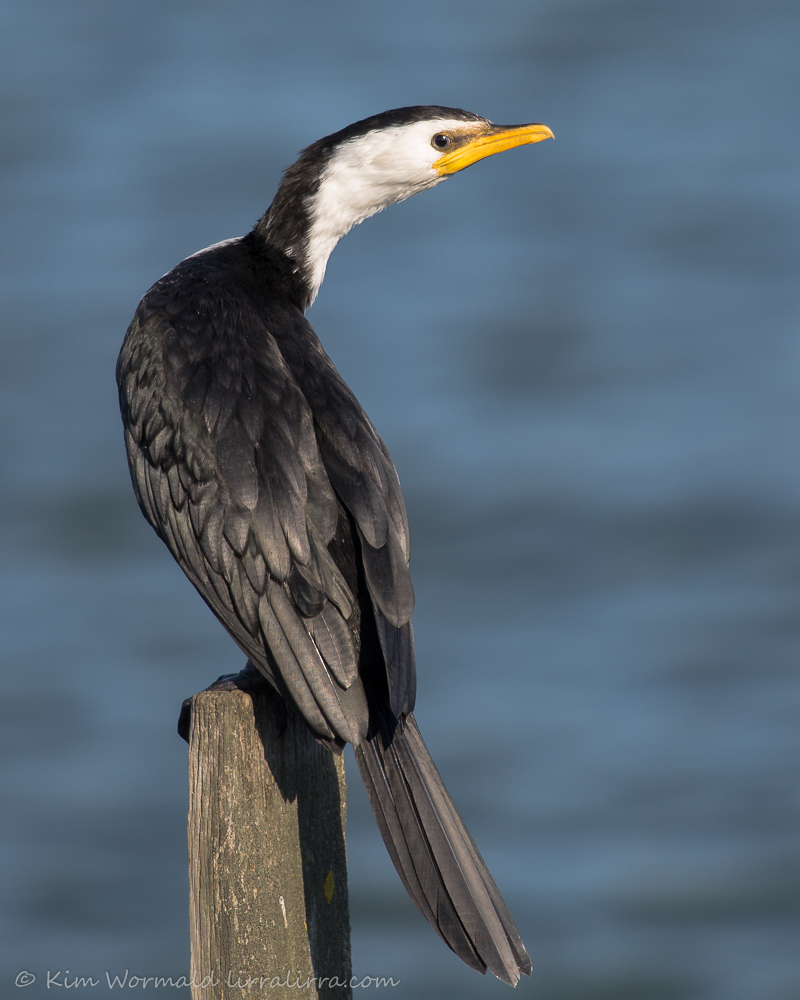Apart from alliteration, the waterbird and the wallaby have little in common except they both feature in today’s post. These images were taken a day’s drive from each other, the first at Werribee Western Treatment Plant and the second in the Snowy Mountains.
 Little Pied Cormorant
Little Pied Cormorant
Canon 5DIII, 100-400mm L IS USM
I often need to go walkabout, if I’ve only got one day spare then a trip to the poo paddocks fits the bill. This cormorant was perched near Gate 8, next to the river, and it allowed me to creep gradually closer until it almost filled the frame. I enjoy taking my time when photographing birds, it becomes a kind of communion rather than me feeling as though I’ve stolen an image and run away with it.
Little Pied Cormorants are a common waterbird that can be found beside rivers, at lakes, dams, wetlands and on beaches where they feed on fish, insects and crustaceans, including yabbies. They have white undersides, black backs and bright yellow bills. This bird is an adult as its white colouring extends above its eye. Pied Cormorants are somewhat similar but are larger with a distinctive orange patch on their faces.
 Red-necked Wallaby
Red-necked Wallaby
Canon 7DII, 100-400mm L IS USM, 1/1250, f/8, ISO 1600, focal length 370mm
I gate-crashed a horse trek trip to Jindabyne with two of my girls; I enjoy driving more than they do and thought I could spend a day birding while they were riding. The idea didn’t work too well as we had 128mm of rain in 24 hours. They still went for their horse ride, which was somewhat disastrous with several people falling from their horses, while I stayed in the cabin and enjoyed reading The Sound of a Wild Snail Eating.
The only wildlife image I managed to get in the Snowy Mountains were of the wallaby above, just as we were heading home. The rain paused for a moment as we looked across at this beautiful animal. It was fairly close and filled the frame at a focal length of 370mm. I upped the ISO to get a decent shutter speed in the hope of catching the wallaby as it hopped away, which it thoughtfully did while I was checking the exposure histogram.
Happy birding, Kim
PS This post was originally titled ‘A cormorant and a kangaroo’ – please see Alison’s comment below. Many thanks Alison, I love learning new things : )
~ Thank you for visiting and commenting
~ If you’d like to receive a weekly email informing you that lirralirra has been updated pleased add your address to the ‘subscribe’ box above right

These shots are fabulous – as always. Love the cormorant and so cool the coloring since ours are all black and rather blah. So you need to tell us about that book too!
Hi Sherry, thank you! We have black and rather blah cormorants too but with amazing eyes. The book is a gentle, insightful read and I recommend it highly.
Two really excellent photos. Great work
Thank you Gwen, much appreciated.
Good stuff and awesome photos. Yeah, it does seem to be a Red Necked Wallaby. I hadn’t seen one before. Glad it was actually, I’ve seen lots of Eastern Greys and the guy you got is only in a small section of Aus. Reckon you’re lucky. Funky blog. I love it. About to google your reading choice, sounds awesome.. 🙂
Now you’ve made me feel extra lucky for having seen a Red-necked Wallaby. I’m glad you enjoy lirralirra and hope you liked the look of the book too.
I enjoy reading about your photography outings. Perfect exposure for the cormorant … terrific detail in the black and the white regions.
Thanks Dave, you definitely have an eye for detail!
Hi Kimberley, beautiful shots. your day of reading sounds very relaxing but I bet you were itching to use your camera as I know I would of been! love them both , love your work 🙂 have a great weekend cheers Janele 🙂
Hi Janele, you’re right! It was frustrating to have driven for 10 hours and not be able to use the camera.A great weekend to you too 🙂
Beautiful photos once again and interesting outline of your adventures. Great to know others love “The Sounds of a Wild Snail Eating.”
It was a perfect book for that day – thank you!
Hello Kim, beautiful pic of both bird and animal. The Kangaroo looks rather more like a Red-Necked Wallaby, with the distinct white strip along upper lip, reddish back and what appears to be a hairless rhinarium. The Eastern Grey has a haired rhinarium ( hairy nose), grey upper parts and lacks the distinctive white stripe. Happy to be proved incorrect.
Many thanks for your wonderful photos.
Alison
Hi Alison, many thanks for the correction, much appreciated. I thought it was a particularly beautiful roo 🙂
LOVE ‘The sound of a wild snail…’ A book I have read, and reread. And will read again.
And the cormorant and the kanga. We are so lucky with our native birds and animals. The cormorants and the kangaroos are usually down by the lake on our visits, and they always make me smile.
I was thinking of you EC when I named the book I was reading, it was perfect for that day.
The kangaroo is simply beautiful!
Thanks for your comment Susan, I thought it looked gorgeous too and was happy to have captured the image.
Hi Kim,
Brilliant photos.
I just want to pat the kangaroo.
Carole.
Thanks Carole, me too!